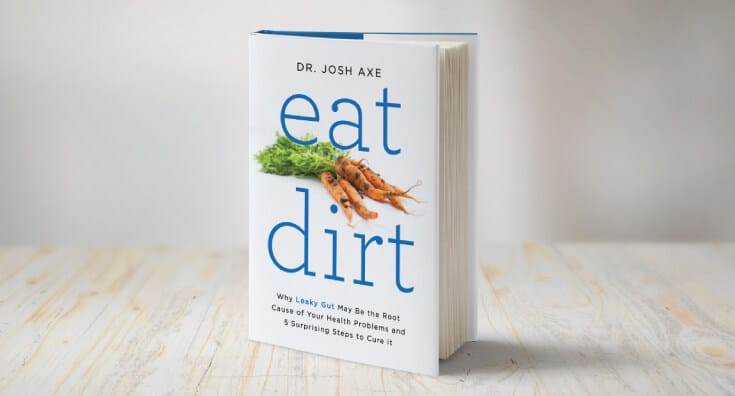This Dr. Axe content is medically reviewed or fact checked to ensure factually accurate information.
With strict editorial sourcing guidelines, we only link to academic research institutions, reputable media sites and, when research is available, medically peer-reviewed studies. Note that the numbers in parentheses (1, 2, etc.) are clickable links to these studies.
The information in our articles is NOT intended to replace a one-on-one relationship with a qualified health care professional and is not intended as medical advice.
This article is based on scientific evidence, written by experts and fact checked by our trained editorial staff. Note that the numbers in parentheses (1, 2, etc.) are clickable links to medically peer-reviewed studies.
Our team includes licensed nutritionists and dietitians, certified health education specialists, as well as certified strength and conditioning specialists, personal trainers and corrective exercise specialists. Our team aims to be not only thorough with its research, but also objective and unbiased.
The information in our articles is NOT intended to replace a one-on-one relationship with a qualified health care professional and is not intended as medical advice.
Why Eating Dirt (aka Soil-Based Organisms) Should Be Part of Your Daily Routine
December 3, 2023

The following is an adapted excerpt from my book “Eat Dirt: Why Leaky Gut May Be the Root Cause of Your Health Problems and 5 Surprising Steps to Cure It“ (Harper Wave)
Is eating dirt part of your diet? Before you get a bad taste in your mouth, consider this: If you were to take away the water in our bodies, you’d be left with mostly dirt. It’s true.
We’re made of 60 of the most abundant elements in the Earth’s crust, an amalgam of its elements, including oxygen, hydrogen, carbon, nitrogen, calcium and phosphorus, with traces of potassium, sulfur, sodium, iron and magnesium. All of these elements come together to make a living, breathing human being.
Now, when I say “eat dirt,” I’m not ordering you to actually scoop up a handful of soil and eat it. (Well, not exactly.) True, ensuring you get daily micro-exposures to soil-based organisms in dirt and other plant life is important for your health. But I urge you to embrace the idea of “eating dirt” as a broader philosophy, an overarching principle I teach my patients when I talk to them about how to treat leaky gut syndrome and feel better again.
Health Benefits of Eating Dirt
Soil-based organisms (SBOs) support gut health and immune response. Why, exactly?
In the plant world, SBOs help plants grow. Without their protection, otherwise healthy plants become malnourished and are susceptible to disease or contamination by fungi, yeasts, molds and candida.
Just as plants grow best in healthy soil teeming with highly active microorganisms, you, too, need these organisms to live a long, healthy life.
More than 800 studies exist in scientific literature that reference soil-based organisms. Their common denominator is that they link SBOs to successfully treating a wide variety of health conditions, including:
- allergies
- asthma
- irritable bowel syndrome
- ulcerative colitis
- flatulence
- nausea
- indigestion
- malabsorption
- nutrient deficiencies
- autoimmune and inflammatory diseases
- bacterial, fungal and viral infections
We now know that SBOs nourish cells in the colon and liver and actually create new compounds, such as B vitamins, vitamin K2, antioxidants and enzymes.
SBOs can destroy or crowd out harmful pathogens, such as candida, fungi and parasites. They also kill off bad bacteria that can bind to or puncture the gut wall. They’ve been shown to bind to toxins and extract them from the body.
SBOs also help regulate the immune system and naturally reduce inflammation in the gut and throughout the entire body.
Missing Vitamin D(irt)
The idea of eating dirt has also been around a long time, dating back to Hippocrates more than 2,500 years ago. You name the civilized cultures in past millennia, and you’ll find a record of those people consciously including a bit of dirt in their diets.
Take the era before refrigeration, for example. Back then, it was common to store food by burying it in the ground or storing it in a dirt cellar, which helped keep bad bacteria and yeast at bay because of the lower temperature and microbes in the soil that help preserve the food.
Today’s generation is missing out on vitamin dirt in a big way, thanks to our collective obsession with oversanitation and antibacterial overkill — like sanitizing hand gels, antibacterial soap and germ-killing wipes. Our connection to dirt is dwindling, too.
Decades ago, vegetable gardens and flower beds dotted almost every backyard, putting people in close contact with the Earth. Kids played outside in the woods from dawn to dust, often after taking care of animals on a farm.
We can’t reverse time, of course, and we’re lucky to be living in an era of such incredible progress. But all of that progress comes with a price, and we must be mindful not to get rid of the benefits along with the problems.
We can add facets of that earlier, simpler lifestyle back into our days, and in doing so we will benefit not only physically, but also emotionally and spiritually and help heal our ailing guts in the process. It starts with eating dirt.
How to Get ‘Dirt’ Into Your Diet
Once you start looking, you’ll find countless ways to bring vital practices into your life that will make eating dirt possible. For example, on any given day, do the following:
1. Don’t Sanitize Your Food
My favorite way to eat dirt is through produce. When I purchase a fresh bunch of organically grown carrots at the farmers market, I know I’m going to be far better off simply rinsing my carrots under running water instead of scrubbing them with a brush and some kind of produce wash, because the surface area of every carrot contains beneficial microbes.
When I do this, I can take in an average 500 milligrams of old-fashioned dirt each day, the same amount the average child consumes when playing outdoors.
Five hundred milligrams, essentially the size of an average supplement capsule, may not sound like much, but there are probably more beneficial microbes in that small amount of dirt than there are people living on Earth today.
2. Eat Probiotic Foods Like Kefir, Yogurt and Sauerkraut
One of the reasons many people today are lactose intolerant (or have an allergy to dairy products) is that pasteurization kills off the beneficial probiotics and enzymes. According to several published medical studies, when someone with lactose intolerance consumes a dairy product that is raw or fermented — which is also higher in probiotics or enzymes — symptoms of lactose intolerance can diminish.
Kefir is especially beneficial, and a study in the Journal of the American Dietetic Association showed that kefir improves lactose digestion and tolerance in adults with lactose malabsorption.
3. Consume Raw Honey and Bee Pollen
Many of us develop seasonal allergies because we don’t spend much time outside and only have periodic exposure to pollen. But bee pollen, which worker bees collect on their bodies as they go to and from the hive, is also effective against a wide range of respiratory diseases.
In a study published in the Journal of Pharmaceutical Biology, researchers found that a mixture of raw honey and bee pollen showed a significant reduction in inflammation, improvement in immune function and protection for the liver.
These gradual and natural immunizations from the microbes in the local honey and pollen take up residence in your gut and help modulate your immune system to adjust to the local environment. Honey also provides an excellent source of prebiotics to nourish the gut bugs as it educates them.

4. Get a Dog
A study published in the medical journal Clinical and Experimental Allergy showed that having pets may improve the immune system and reduce allergies in children. The researchers studied 566 children with pets, including dogs and cats, taking blood samples when the children turned 18. They found that children who had cats had a 48 percent decrease in allergies, and those with dogs had a 50 percent decrease in allergies.
The explanation? An animal that plays in the dirt brings diverse microbes into the home, some of which the kids may breathe in and others that enter through the skin from touching their furry friends.
5. Swim in the Ocean
You’ve probably heard or experienced for yourself how a cut seems to heal quickly after a dip in the ocean. Part of that is due to the salt content of the water, but the good microbes and bacteriophages present in salt water also have therapeutic merit.
A 2013 study in Seminars in Arthritis and Rheumatism found that those who took baths in mineral salts from the Dead Sea had a decrease in skin inflammation, rheumatoid arthritis and psoriasis.
6. Get Grounded
Just the simple act of putting your bare feet on the ground can affect your health in several surprising ways. When you stroll barefoot on grass, dirt paths, shoreline sand or even concrete sidewalks after a rainstorm, the soles of your bare feet come into direct contact with the surface of the Earth, creating the opportunity for billions of bacteria and other beneficial microbes to catch a ride.
Researchers have become so fascinated with the health benefits of walking barefoot that it’s given rise to a whole new field of study on the practice called “earthing” or “grounding.”
A study in the Journal of Environmental and Public Health found that the Earth’s negative charges can literally “ground” us, similar to a grounding wire of an electrical tower. The connection between our skin and the Earth’s surface may help stabilize our internal bioelectrical environment in a way that regulates the normal functioning of our body systems. Researchers believe this exchange of electrical charge may factor into setting the biological clock, regulating circadian rhythms and balancing cortisol levels.
A 2006 study published in the Journal of European Biology and Bioelectromagnetics found that after participants engaged in earthing, their cortisol levels reverted to normal levels and rhythms, rising in the morning and falling in the late afternoon.
Just kicking off your shoes and walking on the ground for a few minutes every day could help you absorb this beneficial combination of electrical currents and microbes (or what I like to call “vitamin G”).
7. Eat Dirt — Literally
Perhaps one of the best dirt-based supplements is shilajit — pronounced shee-lay-jit — which comes from dense, nutrient- and mineral-rich soil high in the Himalayan mountains bordering India and Tibet.
Shilajit contains at least 85 minerals, including two of my favorites — humic acid and fulvic acid — that are commonly used as a soil supplement in agriculture. Fulvic acid and humic acid help the body transport minerals through thick cell walls and prolong cell life.
Conclusion
- Just as plants grow best in healthy soil teeming with highly active microorganisms, you, too, need these organisms to live a long, healthy life. SBOs have been linked to treating conditions like allergies, asthma, IBS, ulcerative colitis, flatulence, nausea, indigestion, malabsorption, nutrient deficiencies, autoimmune and inflammatory diseases, and bacterial, fungal and viral infections.
- SBOs also help regulate the immune system and naturally reduce inflammation in the gut and throughout the entire body.
- In order to start eating dirt, don’t sanitize your food, eat probiotic foods, consume raw honey and bee pollen, get a dog, swim in the ocean, get grounded, and eat dirt — literally.





